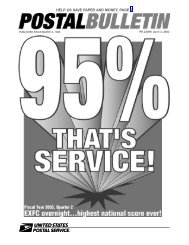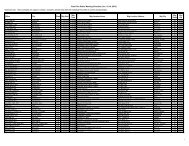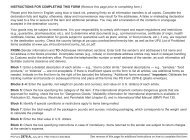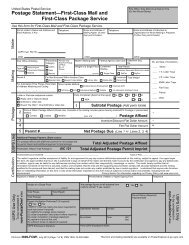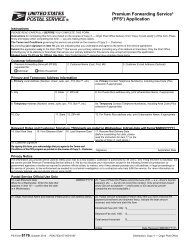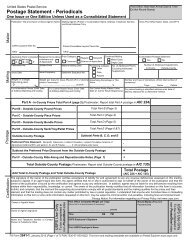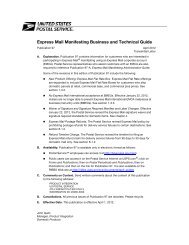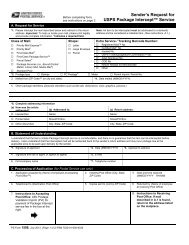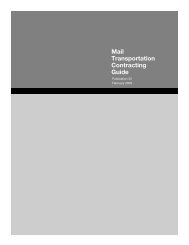Postal Bulletin 22144 - December 23, 2004 - USPS.com
Postal Bulletin 22144 - December 23, 2004 - USPS.com
Postal Bulletin 22144 - December 23, 2004 - USPS.com
You also want an ePaper? Increase the reach of your titles
YUMPU automatically turns print PDFs into web optimized ePapers that Google loves.
POSTAL BULLETIN <strong>22144</strong> (12-<strong>23</strong>-04)<br />
Under “References” in the right-hand column, under<br />
“Policies,” click on PolicyNet.<br />
Click on Handbooks.<br />
(The direct URL for the <strong>Postal</strong> Service PolicyNet Web<br />
site is http://blue.usps.gov/cpim.)<br />
Handbook EL-801, Supervisor’s Safety<br />
Handbook<br />
* * * * *<br />
4 Processing and Distribution Operations<br />
* * * * *<br />
4-7 Powered Industrial Trucks<br />
[Revise 4-7 to read as follows:]<br />
4-7.1 General<br />
Make sure that operators are trained and authorized to operate<br />
powered industrial trucks (PITs) as described in<br />
OSHA 1910.178 — such as tow motors, fork trucks, tractors,<br />
platform lift trucks, motorized hand trucks, and other<br />
specialized industrial trucks powered by electric motors or<br />
internal <strong>com</strong>bustion engines.<br />
All PIT-related accidents and near misses, including property<br />
damage, must be investigated and reported on a Form<br />
1769. Fuel-powered industrial trucks are generally<br />
prohibited indoors. Consult with your local safety professional<br />
before using a fuel-powered industrial truck.<br />
PIT operators are responsible for ensuring vehicle safety<br />
and following all safety requirements. Please consult the<br />
manufacturer’s safe operating manual or your local safety<br />
professional if you have any questions.<br />
4-7.2 General Rules for Operating PIT<br />
Reckless operation is strictly prohibited. When using a PIT,<br />
the operator must follow the safety procedures listed below:<br />
a. Before using the PIT, check the brakes, steering<br />
apparatus, horn, and other <strong>com</strong>ponents, and report<br />
defects immediately.<br />
b. Always wear the seat belts provided any time a PIT is<br />
in motion.<br />
c. Do not exceed the maximum speed limit (about the<br />
speed of a fast walk). Use only the designated vehicle<br />
traffic lanes and keep the PIT to the right whenever<br />
possible.<br />
d. Do not use the reverse control as a brake.<br />
e. Never allow passengers to ride on a PIT unless approved,<br />
securely attached seating is provided, and<br />
never exceed the seating capacity of the unit.<br />
f. Never disengage, cover up, or bypass any audible or<br />
visual warning device.<br />
39<br />
g. Never ride with any part of the body protruding from<br />
the truck.<br />
h. Always determine that there is adequate clearance<br />
before driving under any overhead obstruction.<br />
i. Always check for a clear path to the rear before backing<br />
a truck.<br />
j. Stay at least three vehicle lengths behind other<br />
trucks when traveling.<br />
k. Check bridge or dock plates for proper stability before<br />
driving across.<br />
l. Always approach tow conveyor crossings and all intersecting<br />
aisles slowly and cautiously, and sound a<br />
horn to warn pedestrians of approach.<br />
m. Before dismounting, stop the truck, place the truck in<br />
neutral gear, set the brake, turn off the engine, and<br />
remove the key.<br />
4-7.3 Lift Trucks<br />
Make sure that lift truck operators follow the safe procedures<br />
listed below:<br />
a. Lift, lower, and carry loads on a lift truck with the lifting<br />
mechanism in a vertical position or tilted back —<br />
never forward.<br />
b. Face in the direction the truck is moving and be careful<br />
of rear-end swing when turning corners.<br />
c. When approaching or leaving a building where the<br />
ramp incline is greater than 10 degrees, turn the lift<br />
truck so the load is on the upgrade side and cannot<br />
slip off the forks.<br />
d. Keep forks on a moving lift truck low (just high<br />
enough to clear any floor obstructions and low<br />
enough to clear overhead obstructions). Under normal<br />
conditions, 3 to 6 inches above floor level should<br />
be sufficient.<br />
e. Neither raise nor lower forks while the forklift is in motion.<br />
When a lift truck is parked, fully lower the forks,<br />
place controls in neutral, shut off power, set the<br />
brake, and remove the key.<br />
f. Before entering a truck or trailer with a forklift, inspect<br />
the floor for damage or decay that might cause the lift<br />
to break through the floor. The truck or trailer must be<br />
properly chocked or the dock locks engaged. See 4-6<br />
for additional information.<br />
4-7.4 PIT Warning Devices and Protective<br />
Equipment<br />
Equip all PITs with a horn and a flashing warning beacon<br />
that is in working order. Industrial lift trucks are not to be operated<br />
with the overhead guard or load backrest removed.<br />
PIT drivers must wear personal protective equipment



